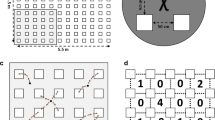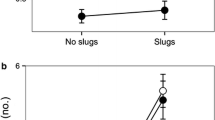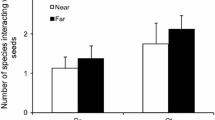Abstract
In order to understand the dynamics of co-evolution it is important to consider spatial variation in interaction dynamics. We examined the relative importance of ant activity, diversity and species identity in an ant seed dispersal mutualism at local, regional and continental scales. We also studied the determinants of seed dispersal rates and dispersal distances at eight sites in the Eneabba sandplain (29.63 S, 115.22 E), western Australia to understand local variation in seed dispersal rate and distance. To test the generality of the conclusions derived from the eight local sites, we established 16 sites along a 1650-km transect in western Australia, covering 11° of latitude and a six-fold increase in rainfall, at which we sampled the ant assemblage, estimated ant species richness and ant activity and observed the removal rate of myrmecochorous seeds. We also assessed the importance of ant species identity at a continental scale via a review of studies carried out throughout Australia which examined ant seed dispersal. Among the eight sandplain shrubland sites, ant species identity, in particular the presence of one genus, Rhytidoponera, was associated with the most dispersal and above average dispersal distances. At the landscape scale, Rhytidoponera presence was the most important determinant of seed removal rate, while seed removal rate was negatively correlated with ant species richness and latitude. Most ant seed removal studies carried out throughout Australia reinforce our observations that Rhytidoponera species were particularly important seed dispersers. It is suggested that superficially diffuse mutualisms may depend greatly on the identity of particular partners. Even at large biogeographic scales, temporal and spatial variation in what are considered to be diffuse mutualisms may often be linked to variation in the abundance of particular partners, and be only weakly – or negatively – associated with the diversity of partners.


Similar content being viewed by others
References
Andersen AN (1986) Diversity, seasonality and community organization of ants at adjacent heath and woodland sites in south-eastern Australia. Aust J Zool 34:53–64
Andersen AN (1988) Dispersal distance as a benefit of myrmecochory. Oecologia 75:507–511
Andersen AN (1990) The use of ant communities to evaluate change in Australian terrestrial ecosystems: a review and a recipe. Proc Ecol Soc Aust 16:347–357
Andersen AN (1991) Responses of ground-foraging ant communities to three experimental fire regimes in a savanna forest of tropical Australia. Biotropica 23:575–585
Andersen AN (1992) Regulation of “momentary” diversity by dominant species in exceptionally rich ant communities of the Australian seasonal tropics. Am Nat 140:401–420
Andersen AN (1993) Ant communities in the Gulf Region of Australia’s semi-arid tropics: species composition, patterns of organisation, and biogeography. Aust J Zool 41:399–414
Andersen AN, Ashton DH (1985) Rates of seed removal by ants at heath and woodland sites in southeastern Australia. Aust J Ecol 10:381–390
Andersen AN, McKaige ME (1987) Ant communities at Rotamah Island Victoria, with particular reference to disturbance and Rhytidoponera tasmaniensis. Proc Roy Soc Victoria 99:141–146
Andersen AN, Morrison SC (1998) Myrmecochory in Australia’s seasonal tropics: Effects of disturbance on distance dispersal. Aust J Ecol 23:483–491
Ashton DH (1979) Seed harvesting by ants in forests of Eucalyptus regnans F. Muell in central Victoria. Aust J Ecol 4:265–277
Auld TD (1986) Population dynamics of the shrub Acacia suaveolens (Sm.) Willd.: Dispersal and the dynamics of the soil seed-bank. Aust J Ecol 11:235–254
Auld TD, Denham AJ (1999) The role of ants and mammals in dispersal and post-dispersal seed predation of the shrubs Grevillea (Proteaceae). Plant Ecol 144:201–213
Beattie AJ (1985) The evolutionary ecology of ant-plant mutualisms, 1st edn. Cambridge University Press, Cambridge
Beattie AJ (2006) The evolution of ant pollination systems. Bot Jahrb 127:43–55
Beattie AJ, Culver DC (1981) The guild of myrmecochores in the herbaceous flora of West Virginia forests. Ecology 62:107–115
Berg RY (1975) Myrmecochorous plants in Australia and their dispersal by ants. Aust J Bot 23:475–508
Bestelmeyer BT et al (2000) Field techniques for the study of ground-dwelling ants. In: Agosti D, Majer JD, Alonso LE, Schultz TR (eds) Ants: standard methods for measuring and monitoring biodiversity. Smithsonian Institute Press, Washington D.C., pp 122–144
Brew CR, O’Dowd DJ, Rae ID (1989) Seed dispersal by ants: behaviour-releasing compounds in elaiosomes. Oecologia 80:490–497
Briese DT, Macauley BJ (1981) Food collection within an ant community in semi-arid Australia, with special reference to seed harvesters. Aust J Ecol 6:1–19
Calviño-Cancela M, Dunn RR, van Etten EJB, Lamont BB (2006) Emus as non-standard seed dispersers and their potential for long-distance dispersal. Ecography 29:632–640
Clifford HT, Monteith GB (1989) A three phase seed dispersal mechanism in Australian Quinine Bush (Petalostigma pubescens Domin). Biotropica 21:284–286
Colwell RK (2000) User’s guide to EstimateS 6. In. http://viceroyeeb.uconn.edu/estimates
Crawley MJ (2002) Statistical computing: an introduction to data analysis using S-Plus. John Wiley & Sons, London
Davidson DW, Morton SR (1981) Myrmecochory in some plants (F. Chenopodiaceae) of the Australian arid zone. Oecologia 50:357–366
Davidson DW, Morton SR (1984) Dispersal adaptations of some Acacia species in the Australian arid zone. Ecology 65:1038–1051
Drake WE (1981) Ant-seed interaction in dry sclerophyll forest on North Stradbroke Island, Queensland. Aust J Bot 29:293–309
Dunn RR, Parker CR, Sanders NJ (2007a) Disentangling the roles of competition and the environment as drivers of phenological patterns of ant diversity. Biol J Linn Soc (in press)
Dunn RR, Parker CR, Gerhaghty M, Sanders NJ (2007b) Reproductive phenologies in a diverse temperate ant fauna. Ecol Entomol 32:135–142
Fellers JH (1987) Interference and exploitation in a guild of woodland ants. Ecology 68:1466–1478
Garrido JL, Rey PJ, Cerdá X, Herrera CM (2002) Geographical variation in diaspore traits of an ant-dispersed plant (Helleborus foetidus): are ant community composition and diaspore traits correlated? J Ecol 90:446–455
Gibb H, Hochuli DF (2003) Colonisation by a dominant ant facilitated by anthropogenic disturbance: effects on ant assemblage composition, biomass and resource use. Oikos 103:469–478
Gilbert LE (1980) Food web organization and the conservation of neotropical diversity. In: Soulé ME, Wilcox BA (eds) Conservation biology: an evolutionary-ecological perspective. Sinauer, Sunderland, pp 11–33
Gill AM, Groves RH, Noble IR (eds) (1981) Fire and the Australian biota. Australian Academy of Science, Canberra
Gómez C, Espadaler X (1998) Myrmecochorous dispersal distances: a world survey. J Biogeogr 25:573–580
Gorb SN, Gorb EV (1999) Effects of ant species composition on seed removal in deciduous forest in eastern Europe. Oikos 84:110–118
Gotelli NJ, Entsminger GL (2004) EcoSim: Null models software for ecology. Version 7. Acquired Intelligence Inc/Kesey-Bear, Jericho (http://garyentsminger.com/ecosim/index.htm)
Gross CL, Whalen MA, Andrew MH (1991) Seed selection and removal by ants in a tropical savanna woodland in northern Australia. J Trop Ecol 7:99–112
Hnatiuk RJ, Hopkins AJM (1981) An ecological analysis of kwongan vegetation south of Eneabba, Western Australia. Aust J Ecol 6:423–438
Hoffmann BD, Andersen AN (2003) Response of ants to disturbance in Australia, with particular reference to functional groups. Aust Ecol 28:444–464
Horvitz CC, Schemske DW (1986) Seed dispersal of a neotropical myrmecochore: Variation in removal rates and dispersal distance. Biotropica 18:319–323
Howe HF (1979) Fear and frugivory. Am Nat 114:925–931
Hughes L, Westoby M (1990) Removal rates of seed adapted for dispersal by ants. Ecology 71:138–148
Hughes L, Westoby M (1992) Fates of seed adapted for dispersal by ants in Australian sclerophyll vegetation. Ecology 73:1285–1299
Huston MA (1997) Hidden treatments in ecological experiments: re-evaluating the ecosystem function of biodiversity. Oecologia 110:449–460
Ireland C, Andrew MH (1995) Ants remove virtually all western myall (Acacia papyrocarpa Benth.) seeds at Middleback, South Australia. Aust J Ecol 20:565–570
Jordano P (1987) Patterns of mutualistic interactions in pollination and seed dispersal: connectance, dependence asymmetries, and coevolution. Am Nat 129:657–677
Kaspari M, Yuan M, Alonso L (2003) Spatial grain and the causes of regional diversity gradients in ants. Am Nat 161:459–477
Lamont BB, Downes S, Fox JED (1977) Importance-value curves and diversity indices applied to species-rich heathland in Western Australia. Nature 265:438–441
Longino JT, Coddington J, Colwell RK (2002) The ant fauna of a tropical rain forest: estimating species richness three different ways. Ecology 83:689–702
Loreau M et al (2001) Biodiversity and ecosystem functioning: current knowledge and future challenges. Science 294:804–808
Majer JD (1982) Ant-plant interactions in the Darling Botanical District of Western Australia. In: Buckley RC (ed) Ant-plant interactions in Australia. Dr W. Junk Publ, The Hague, pp 45–61
Majer JD (1985) Recolonization by ants of rehabilitated mineral sand mines on North Stradbroke Island, Queensland, with particular reference to seed removal. Aust J Ecol 10:31–48
Majer JD, Lamont BB (1985) Removal of seed of Grevillea pteridifolia (Proteaceae) by ants. Aust J Bot 33:611–618
May JE, Heterick BE (2000) Effects of the costal brown ant, Pheidole megacephala (Fabricius), on the ant fauna of the Perth metropolitan region, western Australia. Pac Conserv Biol 6:81–85
Mesler MR, Lu KL (1983) Seed dispersal of Trillium ovatum (Liliaceae) in second-growth Redwood forests. Am J Bot 70:1460–1467
Moles AT, Westoby M. (2003) Latitude, seed predation and seed mass. J Biogeogr 30: 105–128
Mossop MK (1989) Comparison of seed removal by ants in vegetation on fertile and infertile soils. Aust J Ecol 14:367–374
Ness JN, Bronstein JL, Andersen AN, Holland JN (2004) Ant body size predicts dispersal distance of ant-adapted seeds: implications of small-ant invasions. Ecology 85:1244–1250
Parr CL, Andersen AN, Chastagnol C, Duffaud C (2007) Savanna fires increase rate and distances of seed dispersal by ants. Oecologia 151: 33–41
Pfeiffer M, Nais J, Linsenmair KE (2006) Worker size and seed size selection in ‘seed’-collecting ant ensembles (Hymenoptera: Formicidae) in primary rain forests on Borneo. J Trop Ecol 22: 685–693
Rico-Gray V (1993) Use of plant-derived food resources by ants in the dry tropical lowlands of coastal Veracruz, Mexico. Biotropica 25:301–315
Schatral A, Kailis SG, Fox JED (1994) Seed dispersal by Hibbertia hypericoides (Dilleniaceae) by ants. J R Soc West Aust 77:81–85
Shattuck SO (1999) Australian ants: their biology and identification. CSIRO, Collingwood
Stanton ML (2003) Interacting guilds: Moving beyond the pairwise perspective on mutualisms. Am Nat 162:S10–S23
Stocker GC, Irvine AK (1983) Seed dispersal by Cassowaries (Casuarius casuarius) in North Queensland’s rainforests. Biotropica 15:170–176
Symstad AJ, Tilman D, Willson J, Knops JMH (1998) Species loss and ecosystem functioning: effects of species identity and community composition. Oikos 81:389–397
Thompson JN (2005) The geographical mosaic of coevolution. University of Chicago Press, Chicago
Traveset A, Riera N (2005) Disruption of a plant-lizard seed dispersal system and its ecological effects on a threatened endemic plant in the Balearic Islands. Conserv Biol 19:421–431
Vepsäläinen K, Savolainen R (1990) The effect of interference by formicine ants on the foraging of Myrmica. J Anim Ecol 59:643–654
Whitney KD (2005) Linking frugivores to the dynamics of a fruit color polymorphism. Am J Bot 92:859–867
York A (2000) Long-term effects of frequent low-intensity burning on ant communities in coastal blackbutt forests of southeastern Australia. Aust Ecol 25:83–98
Zamora R (2000) Functional equivalence in plant-animal interactions: ecological and evolutionary consequences. Oikos 88:442–447
Acknowledgements
This paper is contribution CEDD07-2007of the Centre for Ecosystem Diversity and Dynamics, Curtin University of Technology and was funded by an Australian Research Council Discovery Grant (DP0558976). Field and laboratory work was greatly assisted by S. Dalrymple. B. Heterick provided the ant species identifications. Comments by M. Fitzpatrick, B. Heterick, J. Holland, J. Ness, N. Sanders and P. Ward and two anonymous reviewers helped improve the manuscript.
Author information
Authors and Affiliations
Corresponding author
Additional information
Communicated by Peter Clarke.
Rights and permissions
About this article
Cite this article
Gove, A.D., Majer, J.D. & Dunn, R.R. A keystone ant species promotes seed dispersal in a “diffuse” mutualism. Oecologia 153, 687–697 (2007). https://doi.org/10.1007/s00442-007-0756-5
Received:
Accepted:
Published:
Issue Date:
DOI: https://doi.org/10.1007/s00442-007-0756-5




